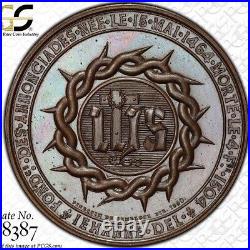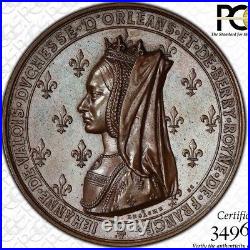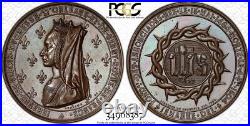Finest & Only At Pcgs & Ngc Sp64 1840 France Medal Jeanne De Valois, Lesache Old




A VERY RARELY SEEN PIECE OF FRANCO-CATHOLIC NUMISMATIC ART WORK! THE "FINEST" & "ONLY" AT BOTH NGC & PCGS! "TOP-POP" & "ONLY ONE" IN ALL GRADES!
1840 FRANCE, JEANNE DE VOLOIS MEDAL, STRUCK IN BRONZE! NICELY MIRRORED FIELDS GIVE A GLOWING CAMEO APPEARANCE TO ST. EXQUISITE DIE WORK BY MASTER CRAFTSMAN "LESACHE" & SIGNED BY SAME! LARGE, 51mm IN DIAMETER, HOUSED IN A PRISTINE OVER-SIZED PCGS SP64 GOLD SHIELD HOLDER! Jeanne de Valois was the daughter, sister, and wife of kings, and eventually became a Saint. Jeanne was known as Jeanne de France, Jeanne de Valois and Joan de France, Queen of France. She was born on April 23, 1464, the second daughter of King Louis XI, the Spider King and his second wife Charlotte of Savoy. Her assigned tutors were deeply faithful Catholics and imparted a solid grounding in faith for their entire household. Jeanne began to take great comfort in prayer and would spend many hours in the castle chapel. The Seigneur even had a path paved between the castle and the chapel to make the walk easier for Jeanne in poor weather.Louis, Duc d'Orléans was the great-grandson of King Charles V and the son of Charles, Duc d'Orléans and had a claim to the French throne. When Louis was fourteen and considered of marriageable age and Jeanne was twelve, their marriage was discussed. The Duc was against the marriage and made this known to the king.
King Louis threatened to make him a monk and hinted he could easily be killed in the guise of a monk's habit. The Duc finally resigned himself to the marriage but told his friends it would be a marriage in name only. Jeanne approved of the marriage but was under no illusions.She was devoted to the Duc but he paid no attention to her. The couple's wedding celebration was performed on September 8, 1476 in Montrichard.
During the ceremony the bridegroom supposedly said he would be better off dead than marrying Jeanne. After the wedding, King Louis intimidated the Duc and compelled him to visit and sleep with his wife several times a year. When the Duc once threatened to end the marriage early on, King Louis put him in prison. Jeanne's father died on August 30, 1483 and her mother died four months later.
King Louis was succeeded by his son, now King Charles VIII. Charles was only thirteen so his sister Anne de Beaujeu became his regent and Jeanne joined the court at Amboise. Jeanne's husband Louis continually fought against Anne's regency in a conflict that was known as the "Mad War". He stayed away from Jeanne as much as possible. He fought in Italy and made some gains there. In 1488, Louis was taken prisoner by Charles' troops. While he was incarcerated, Jeanne managed his estates, especially Milan and Asti in Italy. Louis would be released in 1491 and he would join King Charles when he waged war in Italy in 1494. On April 7, 1498, King Charles was making his way to watch a tennis match through a low gallery at the castle of Amboise when he violently struck his head on the doorway. He managed to view the tennis match and even talk to his companions and wife.Suddenly he fell backwards, never to speak again. At the death of King Charles on April 7th 1498 Jeanne's husband, Louis, Duc d'Orléans, was now King of France as Louis XII and she was his Queen. Less than three months later, Louis had applied to the Pope for an annulment of his marriage to Jeanne so he could marry Anne of Brittany, the former Queen.
Jeanne de Valois by Lesache. Louis cited four reasons for the annulment. The first was the degree of consanguinity, the usual excuse for royal divorce.
He was the second cousin of King Louis XI, Jeanne's father. Next he claimed there was a spiritual relationship.
Louis XI was Louis' godfather. Third, he claimed he married Jeanne under duress. And lastly, he claimed the marriage was never consummated.
Jeanne maintained there were dispensations for the first two reasons and was insistent they had sexual intercourse. In the end, the sworn testimony of a consecrated king carried great weight with the Pope and the annulment was granted on the grounds of coercion. Louis immediately made Jeanne Duchess of Berri which included the domains of Châtillon-sur-Indre, Châteauneuf-sur-Loire and Pontoise as well as an income of 12,000 crowns. She retired to the town of Bourges and she began to work on founding the Order of the Virgin Mary, a new enclosed religious order dedicated to the Annunciaton, and an independent branch of the Poor Clares. She wore the habit of the nuns which was a grey robe, the symbol of repentance, the white cloak of purity and the red scapulary, representing the blood of Christ.
She ministered to the sick and the poor and performed pious works. The hospitals, churches and colleges shared in her beneficence. In May of 1500, she wrote the Rule of Life for the Order herself and it was approved by Pope Alexander VI on February 12, 1502 and the following year construction began on the monastery. Jeanne and Gabriel Maria took vows to follow the Rule on Pentecost Sunday, 1504, effectively making themselves co-founders of the Order. Due to repeated penances which she inflicted on herself, Jeanne's health suffered greatly. On January 10, 1505 she wrote her will. On the 22nd, she made her last visit to the convent and then fell ill. When she died on February 4, 1505, her body was found to be covered with bruises under a hair shirt and iron chains. She had five nails embedded in her chest. She paid homage all her life to the Virgin Mary and when she died, Pope Alexander granted ten thousand days indulgence to all who said the rosary of ten aves composed by Jeanne in honor of the ten virtues of Mary which she strived to imitate: chastity, prudence, humility, faith, obedience, devotion, poverty, patience, charity, and compassion. She was buried in the chapel of the Annonciade monastery. Soon after her death, miracles and healings were attributed to her. In 1562, the Huguenots sacked Bourges, desecrated her grave and burned her body which had been found to be incorrupt. The opening of her beatification was started in 1632 and was granted in 1742 by Pope Benedict XIV. She was canonized on May 28, 1950.The nuns of the order of the Virgin Mary are still living according the Rule of the Order in monasteries in France, Belgium, Costa Rica and Poland and some of the sisters serve in Burundi, Cameroon, the Democratic Republic of the Congo and Guatemala. AN ELEGANT & RARELY SEEN MUSEUM QUALITY PIECE!
Many more really Cool & Exclusive Numismatics..
